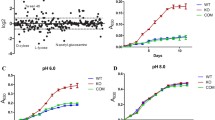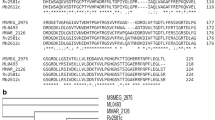Abstract
N-terminal acetylation of proteins is an important post-translational modification (PTM) found in eukaryotes and prokaryotes. In bacteria, N-terminal acetylation is suggested to play various regulatory roles related to protein stability, gene expression, stress response, and virulence; however, the mechanism of such response remains unclear. The proteins, namely RimI/RimJ, are involved in N-terminal acetylation in mycobacteria. In this study, we used CRISPR interference (CRISPRi) to silence rimI/rimJ in Mycobacterium smegmatis mc2155 to investigate the physiological effects of N-terminal acetylation in cell survival and stress response. Repeat analysis of growth curves in rich media and biofilm analysis in minimal media of various mutant strains and wild-type bacteria did not show significant differences that could be attributed to the rimI/rimJ silencing. However, total proteome and acetylome profiles varied significantly across mutants and wild-type strains, highlighting the role of RimI/RimJ in modulating levels of proprotein acetylation in the cellular milieu. Further, we observed a significant increase in the minimum inhibitory concentration (MIC) (from 64 to 1024 µg ml−1) for the drug isoniazid in rimI mutant strains. The increase in MIC value for the drug isoniazid in the mutant strains suggests the link between N-terminal acetylation and antibiotic resistance. The study highlights the utility of CRISPRi as a convenient tool to study the role of PTMs, such as acetylation in mycobacteria. It also identifies rimI/rimJ genes as necessary for managing cellular response against antibiotic stress. Further research would be required to decipher the potential of targeting acetylation to enhance the efficacy of existing antibiotics.






Similar content being viewed by others
Data availability
All data supporting the study are available within the manuscript and supplementary file.
References
Aguilera J, Karki CB, Li L, Reyes SV, Estevao I, Grajeda BI, Zhang Q, Arico CD, Ouellet H, Sun J (2020) Nα-Acetylation of the virulence factor EsxA is required for mycobacterial cytosolic translocation and virulence. J Biol Chem 24:5785–5794
Brodin P, de Jonge MI, Majlessi L, Leclerc C, Nilges M, Cole ST et al (2005) Functional analysis of early secreted antigenic target-6, the dominant T-cell antigen of Mycobacterium tuberculosis, reveals key residues involved in secretion, complex formation, virulence, and immunogenicity. J Biol Chem 280:33953–33959
Brown CW, Sridhara V, Boutz DR, Person MD, Marcotte EM, Barrick JE et al (2017) Large-scale analysis of post-translational modifications in E. coli under glucose-limiting conditions. BMC Genomics. https://doi.org/10.1186/s12864-017-3676-8
Cumberlidge AG, Isono K (1979) Ribosomal protein modification in Escherichia coli: I. A mutant lacking the N-terminal acetylation of protein S5 exhibits thermosensitivity. J Mol Biol 25:169–189
Falb M, Aivaliotis M, Garcia-Rizo C, Bisle B, Tebbe A, Klein C, Konstantinidis K, Siedler F, Pfeiffer F, Oesterhelt D (2006) Archaeal N-terminal protein maturation commonly involves N-terminal acetylation: a large-scale proteomics survey. J Mol Biol 6:915–924
Favrot L, Blanchard JS, Vergnolle O (2016) Bacterial GCN5-related N-Acetyltransferases: from resistance to regulation. Biochemistry 55:989–1002
Isono K, Isono S (1980) Ribosomal protein modification in Escherichia coli: II. Studies of a mutant lacking the N-terminal acetylation of protein S18. Molec Gen Genet 177:645–651
Jones JD, O’Connor CD (2018) Protein acetylation in prokaryotes. Proteomics 11:3012–3022
Kelkar DS, Kumar D, Kumar P, Balakrishnan L, Muthusamy B, Yadav AK et al (2011) Proteogenomic analysis of Mycobacterium tuberculosis by high resolution mass spectrometry. Mol Cell Proteomics 10(M111):011627
Kentache T, Jouenne T, Dé E, Hardouin J (2016) Proteomic characterization of Nα- and Nε-acetylation in Acinetobacter baumannii. J Proteomics 144:148–158. https://doi.org/10.1016/j.jprot.2016.05.021
Mba Medie F, Champion MM, Williams EA, Champion PA (2014) Homeostasis of N-α-terminal acetylation of EsxA correlates with virulence in mycobacterium marinum. Infect Immun 82:4572–4586
MbaMedie F, Champion MM, Williams EA, Champion PAD (2014) Homeostasis of N-α-terminal acetylation of EsxA correlates with virulence in Mycobacterium marinum. Infect Immun 82:4572–4586
Okkels LM, Müller EC, Schmid M, Rosenkrands I, Kaufmann SH, Andersen P et al (2004) CFP10 discriminates between nonacetylated and acetylated ESAT-6 of Mycobacterium tuberculosis by differential interaction. Proteomics 4:2954–2960
Ouidir T, Jarnier F, Cosette P, Jouenne T, Hardouin J (2015) Characterization of N-terminal protein modifications in Pseudomonas aeruginosa PA14. J Proteomics 114:214–225. https://doi.org/10.1016/j.jprot.2014.11.006
Pathak D, Bhat AH, Sapehia V, Rai J, Rao A (2016) Biochemical evidence for relaxed substrate specificity of Nα-acetyltransferase (Rv3420c/rimI) of Mycobacterium tuberculosis. Sci Rep 6:1–12
Pathak D (2016) Studies on Rv3420c encoding a probable N-alpha acetyltransferase and understanding its context in gcp-alr cluster of genes in Mycobacterium tuberculosis. Dissertation, Institute of Microbial Technology Chandigarh.
Polevoda B, Sherman F (2003) N-terminal acetyltransferasesand sequence requirements for N-terminal acetylation of eukaryotic proteins. J Mol Biol 325:595–622
Rawat M, Av-Gay Y (2007) Mycothiol-dependent proteins in actinomycetes. FEMS Microbiol Rev 31:278–292
Ree R, Varland S, Arnesen T (2018) Spotlight on protein N-terminal acetylation. Exp Mol Med 50:1–13
Starheim KK, Gevaert K, Arnesen T (2012) Protein N-terminalacetyltransferases: when the start matters. Trends Biochem Sci 37:152–161
Tanaka S, Matsushita Y, Yoshikawa A, Isono K (1989) Cloning and molecular characterization of the gene rimL which encodes an enzyme acetylating ribosomal protein L12 of Escherichia coli K12. Mol Gen Genet 217:289–293
Thompson CR, Champion MM, Champion PA (2018) Quantitative N-terminal footprinting of pathogenic mycobacteria reveals differential protein acetylation. J Proteome Res 17:3246–3258
Varland S, Osberg C, Arnesen T (2015) N-terminal modifications of cellular proteins: the enzymes involved, their substrate specificities and biological effects. Proteomics 15:2385–2401
Vetting MW, Magnet S, Nieves E, Roderick SL, Blanchard JS (2004) A bacterial acetyltransferase capable of regioselective N-acetylation of antibiotics and histones. Chem Biol 11:565–573
Wang R, Prince JT, Marcotte EM (2005) Mass spectrometry of the M. smegmatis proteome: protein expression levels correlate with function, operons, and codon bias. Genome Res 15:1118–1126
White-Ziegler CA, Low DA (1992) Thermoregulation of the pap operon:evidence for the involvement of RimJ, the N-terminal acetylase of ribosomalprotein S5. J Bacteriol 174:7003–7012. https://doi.org/10.1128/jb.174.21.7003-7012
White-Ziegler CA, Black AM, Eliades SH, Young S, Porter K (2002) The N-acetyltransferase RimJ responds to environmental stimuli to repress pap fimbrial transcription in Escherichia coli. J Bacteriol 184:4334–4342. https://doi.org/10.1128/jb.184.16.4334-4342
Yoshikawa A, Isono S, Sheback A, Isono K (1987) Cloning and nucleotide sequencing of the genes rimI and rimJ which encode enzymes acetylating ribosomal proteins S18 and S5 of Escherichia coli K12. Mol Gen Genet 209:481–488
Acknowledgements
The authors thank Dr. Deepika Pathak for generating the initial KO of rimI that inspired and facilitated this study.
Funding
This work was supported by the Department of Biotechnology, Govt. of India (grant no. BT/PR25690/GET/119/142/2017).
Author information
Authors and Affiliations
Contributions
MP, AR, and NA designed the experiments. PP prepared the CRISPRi constructs and the respective knockdown strains. MP and VKY performed physiological experiments. MP performed MIC and proteomics experiments. MP, VKY and AR analyzed and interpreted the data. MP, VKY and AR wrote and edited the manuscript. All authors reviewed the manuscript. AR and NA supervised the project.
Corresponding authors
Ethics declarations
Conflict of interest
The authors declare no competing interests.
Additional information
Communicated by Yusuf Akhter.
Publisher's Note
Springer Nature remains neutral with regard to jurisdictional claims in published maps and institutional affiliations.
Supplementary Information
Below is the link to the electronic supplementary material.
Rights and permissions
Springer Nature or its licensor (e.g. a society or other partner) holds exclusive rights to this article under a publishing agreement with the author(s) or other rightsholder(s); author self-archiving of the accepted manuscript version of this article is solely governed by the terms of such publishing agreement and applicable law.
About this article
Cite this article
Pal, M., Yadav, V.K., Pal, P. et al. The physiological effect of rimI/rimJ silencing by CRISPR interference in Mycobacterium smegmatis mc2155. Arch Microbiol 205, 211 (2023). https://doi.org/10.1007/s00203-023-03561-5
Received:
Revised:
Accepted:
Published:
DOI: https://doi.org/10.1007/s00203-023-03561-5




